在风化和热液蚀变等地球化学过程中一些元素通常被认为是不活动元素,例如Al2O3(Ji et al.,2000;Pokrovsky et al.,2006;Das and Krishnaswami,2007)和Ti(Nesbitt and Markovics,1997;Panahi et al.,2000;Braun et al.,2009)。这些元素常常被用来指示地球化学作用过程中其他元素的行为(Nesbitt and Markovics,1997;Duzgoren-Aydin et al.,2002;Gong et al.,2011)。不活动元素的比值Al2O3/Ti常被作为一个地球化学参数,用于追溯风化产物的母岩(Duzgoren-Aydin et al.,2002; Gong et al.,2011,2015)。
常用的划分火成岩类型的图解有全碱-硅(TAS)图解和QAPF图解。TAS图解是根据岩石中全碱(Na2O+K2O)和二氧化硅(SiO2)的百分含量对岩石类别进行划分。构建此图解的SiO2、K2O和Na2O这三种氧化物在风化和蚀变等地球化学作用过程中往往被认为是活动的(Duzgoren-Aydin et al.,2002),易被活化迁移,因此TAS图解只适用于新鲜火成岩(针对喷出岩)岩石类型的判别,不适用于受风化或蚀变作用的火成岩(Le Maitre,1989;Rollison et al.,2000)。QAPF图解法是根据岩石(针对侵入岩)中矿物含量对岩浆岩类别进行划分,判别岩性时要求岩石中矿物相对含量明确确定(Streckeisen,1974)。然而,在地球化学作用过程中岩石的化学组成和矿物组成均会发生不同程度的变化,尤其是原岩遭受强烈风化或蚀变时。上述两种图解只适用于新鲜火成岩的判别,目前尚缺少对受风化或蚀变作用影响明显的岩石的母岩的岩性判别图解。
本文结合地球化学参数Al2O3/Ti与TAS图解,尝试构建一个新的判别火成岩岩石类型的图解,该图解不仅能够区分新鲜岩石的岩性类别,还可以对受风化或蚀变作用影响的岩石同样适用。
2 Al2O3/Ti图解的构建 2.1 数据源本次研究数据来源于《应用地球化学元素丰度数据手册》(迟清华和鄢明才,2007)第一章节《火成岩化学组成与元素丰度》中全部158件火成岩的样品数据,在剔除其中1件碳酸岩样品后剩余157件。
参照Le Maitre(1989)提出的火山岩全碱-硅(TAS)图解分类,数据源中157件火成岩样品在TAS图解中的投影如图 1所示。如果仅按照TAS图解中SiO2含量(%)(酸度)来划分,火成岩可划分为6类(如图 2所示):a-酸性岩(SiO2>69%),b-中酸性岩(SiO2=63%~69%),c-中性岩(SiO2=57%~63%,d-中基性岩(SiO2=52%~57%),e-基性岩(SiO2=45%~52%),f-超基性岩(SiO2<45%)。中基性岩和中性岩是依据TAS图解中玄武质安山岩与安山岩的SiO2边界值(SiO2=57%)来进行划分;中酸性岩和酸性岩是依据TAS图解中流纹岩SiO2含量的最小临界值(SiO2=69%)来进行划分。按照上述6类火成岩划分标准,157件火成岩样品中超基性岩为4件,基性岩为27件,中基性岩为13件,中性岩为26件,中酸性岩为25件,酸性岩为62件。

|
图 1 数据源样品的TAS图解中的分布特征图(底图引自Le Maitre,1989;其中碱性与亚碱性分界线引自Irvine and Baragar,1971) a-酸性岩,n=62;b-中酸性岩,n=25;c-中性岩,n=26;d-中基性岩,n=13;e-基性岩,n=27;f-超基性岩,n=4.氧化物的含量为不含H2O和CO2重新折算的质量百分数 a-felsic rock,n=62; b-intermediate-felsic rock n=25; c-intermediate rock,n=26; d-Intermediate-mafic rock,n=13; e-mafic rock,n=27; f-ultra-mafic rock,n=4. The contents of oxides were recalculated after excluding the contents of H2O and CO2 Fig. 1 The distribution of source samples in the TAS diagram(after Le Maitre,1989; the boundary between alkali and sub-alkali after Irvine and Baragar,1971) |

|
图 2 数据源样品中Al2O3/Ti与SiO2的关系图 a-酸性岩;b-中酸性岩;c-中性岩;d-中基性岩;e-基性岩;f-超基性岩;黑色×为拟合经验方程时剔除的样品点;拟合实线方程为ln(Al2O3/Ti)=0.073×SiO2-0.89,其中n=148,R2=0.91 a-felsic rock;b-intermediate-felsic rock;c-intermediate rock;d-intermediate-mafic rock;e-mafic rock;f-ultra-mafic rock; ×represents the eliminated data when fitting an empirical equation; fitted line is ln(Al2O3/Ti)=0.073×SiO2-0.89 on 148 dots with R2=0.91 Fig. 2 Al2O3/Ti vs. SiO2 diagram of source samples |
为了探讨不同岩性中Al2O3/Ti的特征,我们绘制了157件火成岩样品Al2O3/Ti与SiO2含量的关系图(图 2),为了统一变量单位,Al2O3,SiO2和Ti含量的单位均采用%。
由图 2可以看出,随着火成岩样品中SiO2含量的增大,Al2O3/Ti也随之增大。由于超基性岩中Al2O3和Ti的含量极少,Al2O3/Ti误差较大,因此剔除超基性岩的4件样品,剩余的153件火成岩样品的Al2O3/Ti与SiO2存在较好的幂函数关系。我们尝试拟合出两者的定量关系,剔除5件偏离较远的样品后拟合出148件火成岩样品SiO2与Al2O3/Ti平均含量关系的经验方程,方程式为:
| $In\left( A{{l}_{2}}{{O}_{3}}/Ti \right)=0.073\times Si{{O}_{2}}-0.89\left( n=148,{{R}^{2}}=0.91 \right)$ | (1) |
式中Al2O3、SiO2和Ti元素含量单位量均为%,拟合结果满足显著性检验要求。
经验方程拟合线与上述6类岩性岩石的分界线(SiO2(%)=45,52,57,63,80)的交点的纵轴坐标值分别为11.2,18.8,27.2,42.3,65.7。因此,基性岩样品的Al2O3/Ti的大致变化范围为11.2~18.8;中基性岩的Al2O3/Ti的变化范围为18.8~27.2;中性岩的Al2O3/Ti的变化范围为27.2~42.3;中酸性岩的Al2O3/Ti的变化范围为42.3~65.7;酸性岩的Al2O3/Ti的比值一般大于65.7。不同岩性的火成岩岩石具备特定的Al2O3/Ti比值范围。因此Al2O3/Ti和SiO2一样可以作为一个区分岩性的地球化学指标。
2.3 Al2O3-Ti图解为了进一步研究Al2O3/Ti与岩性的关系,我们绘制了上述157件火成岩样品的Al2O3与Ti的关系图(图 3a)。
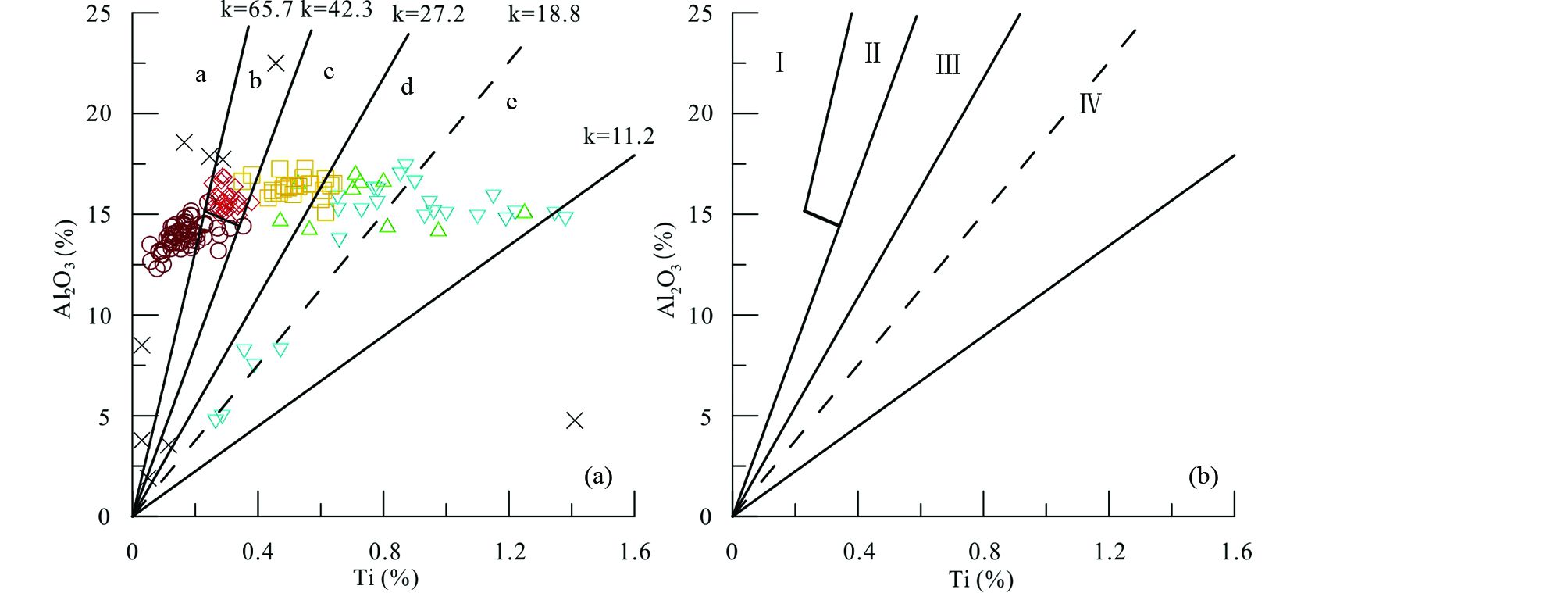
|
图 3 数据源样品的Al2O3-Ti关系图 a-酸性岩区;b-中酸性岩区;c-中性岩区;d-中基性岩区;e-基性岩区;黑色×为拟合经验方程时剔除的样品点;图 3b:I-酸性岩区;Ⅱ-中酸性岩区;Ⅲ-中性岩区;IV-中基性岩和基性岩区 Al2O3 versus Ti diagram of source samples Fig. 3 a-felsic rock; b-intermediate-felsic rock; c-intermediate rock; d-intermediate-mafic rock; e-mafic rock; ×represents the eliminated data when fitting a empirical equation. In Fig. 3b: I-felsic rock; Ⅱ-intermediate-felsic rock; Ⅲ-intermediate rock; IV-intermediate-mafic rock and mafic rock |
由图 3a可以看出,不同岩性的火成岩样品在Al2O3-Ti关系图中的投点分别聚集在不同范围。上述Al2O3/Ti-SiO2关系图(图 2)中不同岩性火成岩的Al2O3/Ti比值的分界值在Al2O3-Ti关系图中体现为5条过原点的直线(图 3a),斜率分别为11.2,18.8,27.2,42.3和65.7。不同岩性岩石Al2O3/Ti比值的变化范围对应为相邻直线扫过的弧区范围。Al2O3-Ti关系图可以划分出五个不同岩性区:a-酸性岩区;b-中酸性岩区;c-中性岩区;d-中基性岩区;e-基性岩区(图 3a)。
由图 3a可知,有一部分酸性岩样品点落在了中酸性岩区(b区),但不难发现b区内中酸性岩样品绝大多数位于该区酸性岩样品的上部,二者具有明显的分界线。依据数据源中这两类岩石样品Al2O3与Ti的含量我们绘出了二者的分界线。将分界线以上的b区作为中酸性岩岩石的识别区,记为Ⅱ区。将a区和分界线以下的b区合并作为中酸性岩的识别区,区记为I区(图 3b)。此外,由图 3a可见,中基性岩区(d区)和基性岩区(e区)的边界线不能很好地区分数据源中这两类岩石样品,因此我们将这两个区合并记为IV区(基性和中基性岩区),将两区的原先的边界线用虚线表示(图 3b)作为参照。对于没有更改的中性岩区(c区)记为Ⅲ区。构建的Al2O3-Ti图解如图 3b所示。在进行岩性判别时,将样品中Al2O3与Ti两项的含量投至Al2O3-Ti图解中则可大致判断岩石样品的岩性。值得注意的是在构建图解过程中我们发现由于超基性岩中Al2O3和Ti的含量极少,Al2O3/Ti误差较大,在构建图解时剔除了超基性岩样品,因此该图解不适用于超基性岩样品的判别。
Al2O3-Ti图解由不活动组分Al2O3和Ti构建,理论上同样适用于风化或蚀变的岩石。本文选取了山东胶东地区、河南熊耳山地区和北京周口店地区三个地区新鲜岩石样品、火成岩风化剖面样品和蚀变岩样品来探讨构建的Al2O3-Ti图解的应用。
3 Al2O3/Ti区分岩浆岩类别 3.1 数据源为了验证构建的Al2O3-Ti图解在区分岩浆岩类别时的应用,我们选取了胶东玲珑花岗岩样品24件(Yang et al.,2012),北京周口店房山岩体花岗闪长岩样品9件(Xu et al.,2012;蔡剑辉等,2005),河南熊耳群玄武质安山岩样品8件(Wang et al.,2010)。岩石样品的TAS图解见图 4。按照上文所述的仅按照TAS图解中SiO2含量划分火成岩方案,所选取的胶东地区花岗岩属于酸性岩,北京周口店地区花岗闪长岩属于中酸性岩,河南熊耳山地区玄武质安山岩属于中基性岩。
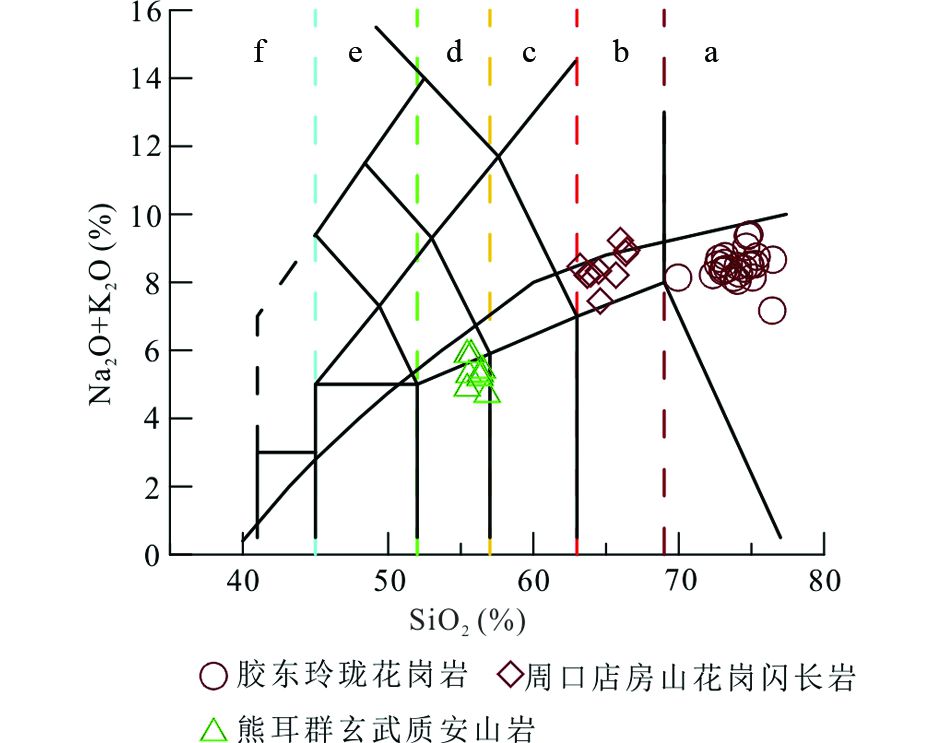
|
图 4 岩石样品在TAS图解中的分布特征图 a-酸性岩区;b-中酸性岩区;c-中性岩区;d-中基性岩区;e-基性岩区;f-超基性岩区 a-felsic rock;b-intermediate-felsic rock;c-intermediate rock;d-intermediate-mafic rock;e-mafic rock;f-ultra-mafic rock Fig. 4 The distribution of igneous rock samples in the TAS diagram |
将上述41件岩石样品投入Al2O3-Ti图解中(图 5),可见花岗岩样品落在I区(酸性岩区),花岗闪长岩落在Ⅱ区(中酸性岩区)(其中部分样品沿着Ⅱ区和Ⅲ区的分界线分布,这与其在TAS图解中沿着SiO2=57%线分布一致),玄武质安山岩落在IV区(中基性岩和基性岩区)。岩石样品根据Al2O3-Ti图解划分岩性结果与参照TAS图解划分岩石类型一致。可见Al2O3-Ti图解能较好的区分岩性。
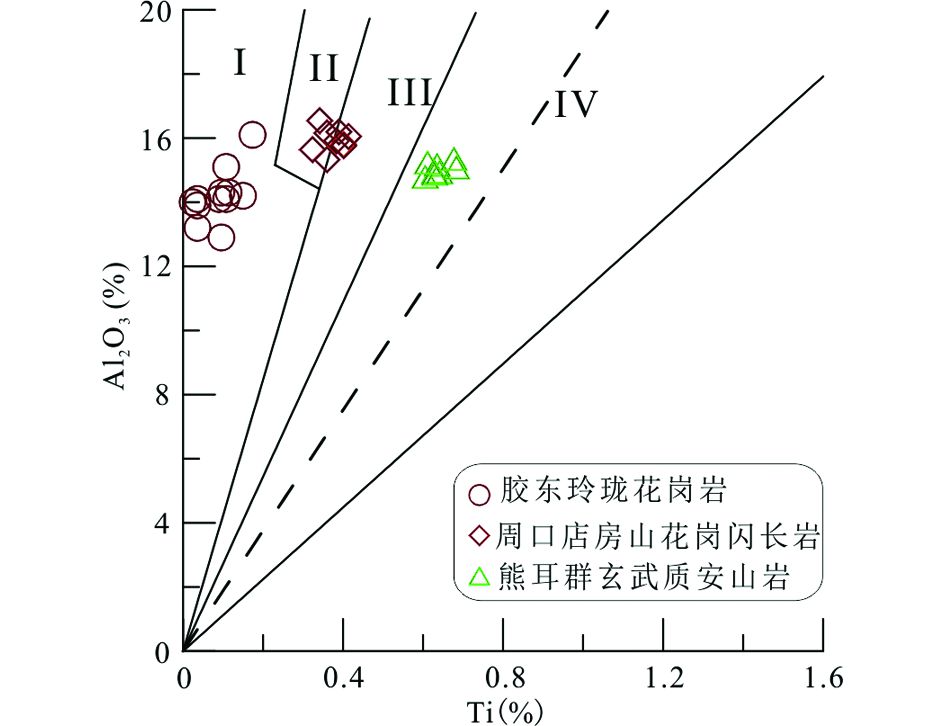
|
图 5 岩石样品的Al2O3-Ti图解 Ⅰ-酸性岩区;Ⅱ-中酸性岩区;Ⅲ-中性岩区;IV-中基性岩和基性岩区 Ⅰ-felsic rock;Ⅱ-intermediate-felsic rock;Ⅲ-intermediate rock;IV-intermediate-mafic rock and mafic rock Fig. 5 Al2O3-Ti diagram of igneous rock samples |
在运用TAS图解判别岩性时,需先剔除样品中H2O和CO2含量,对SiO2、K2O和Na2O的含量进行重新折算。而在利用Al2O3-Ti图解法区分岩性时,只需测得Al2O3和Ti含量,无需对氧化物含量进行重新换算。这相对于TAS图解更为方便。
4 Al2O3/Ti示踪岩浆岩风化产物的母岩在风化过程中Al2O3和Ti两元素通常被认为是不活动元素。两者的比值Al2O3/Ti在风化过程中应该保持不变,风化产物中的Al2O3/Ti的值保留着其母岩中两元素的初始比值。因此Al2O3-Ti图解理论上可以用来示踪岩浆岩风化产物的物源。

|
图 6 风化剖面样品在Al2O3-Ti图解中的投点图 Ⅰ-酸性岩区;Ⅱ-中酸性岩区;Ⅲ-中性岩区;IV-中基性岩和基性岩区 Ⅰ-felsic rock;Ⅱ-intermediate-felsic rock;Ⅲ-intermediate rock;IV-intermediate-mafic rock and mafic rock Fig. 6 Al2O3-Ti diagram of samples from weathering profile |
风化壳作为一个研究风化作用的典型模型得到了广泛研究(Ji et al.,2000,2004;Ma et al.,2007;Gong et al.,2011,2013,2015),风化壳样品从底部新鲜岩石到风化岩石到表层土壤,代表着风化作用的不同阶段。不同层位的风化壳样品代表着不同风化程度的风化产物。通过对风化壳的研究可以很好地了解风化过程中元素的行为。
本次研究参照已经报道过的3个火成岩风化剖面,分别为胶东地区Z01风化剖面(Gong et al.,2013),河南熊耳山地区D06风化剖面(马云涛等,2015)和北京周口店地区ZKD2风化剖面(Gong et al.,2015)。
Z01风化剖面位于胶东焦家金矿望儿山地区以东,为一发育在玲珑黑云母花岗岩上的风化剖面,剖面高约7.5m,从表层土壤到底部新鲜黑云母花岗岩共收集了11件样品(Gong et al.,2013)。ZKD2风化剖面位于北京东南部,为一发育在花岗闪长岩上的风化剖面,剖面高约7m,从表土层到底部花岗闪长岩共收集了20件样品(Gong et al.,2015)。D06风化剖面位于豫西熊耳山地区,为一母岩为玄武质安山岩的风化剖面,剖面高约7m,从表土层到底部花岗闪长岩共收集了11件样品(马云涛等,2015)。
4.2 Al2O3-Ti图解示踪收集到的上述3个风化剖面的42件样品在Al2O3-Ti图解中的投点如图 6所示。
从图 6可以看出,不同岩性岩石的风化产物在Al2O3-Ti图解中分别聚集在不同的区域。花岗岩从新鲜基岩到风化岩石到风化形成的土壤在Al2O3-Ti图解中均落在酸性岩区,花岗闪长岩样品从新鲜基岩到风化岩石到风化形成的土壤在Al2O3-Ti图解中大部分落在中酸性岩区,部分样品落在中性岩区,玄武质安山岩样品从新鲜基岩到风化岩石到风化形成的土壤在Al2O3-Ti图解中均落在中基性岩-基性岩区。
显然,从表层土壤到风化岩石到底部的基岩,虽然岩石经历了不同程度的风化作用,但其风化产物与其母岩对应的区域一致。因此Al2O3-Ti图解可以用来追溯岩石风化产物的母岩。借助Al2O3-Ti图解,通过研究风化产物可以追溯和判别其物质来源。例如对于一个地区风化形成的土壤我们借助Al2O3-Ti图解,可以判别土壤风化前的母岩性质,结合该区地质背景进一步推断风化产物(土壤)的物质来源。这对矿产勘查或者环境污染源问题的研究有一定的指导意义。
5 Al2O3/Ti判别蚀变岩石的原岩在热液蚀变过程中,Al2O3和Ti通常被认为是不活动的,常被选为不活动元素来进行质量平衡计算(Barton et al.,1991; Condie and Sinha,1996;Das and Krishnaswami,2007;Gong et al.,2016)。即岩石在蚀变过程中Al2O3/Ti的比值保持相对稳定,蚀变岩中特征参数Al2O3/Ti与其新鲜岩石中的Al2O3/Ti保持一致。因而,Al2O3-Ti图解应当可以用来判别蚀变岩石的母岩。本文选取胶东地区和豫西地区岩石及其蚀变岩来进行研究。
5.1 数据源胶东作为中国最重要的金矿集区,区内大型-超大型金矿床集中产出(Deng and Wang,2016;杨立强等,2000,2006; Yang et al.,2006;王中亮,2012),已探明金矿资源量占全国近1/3(Deng et al.,2003,2006,2008,2011;Yang et al.,2007;杨立强等,2007);其中,破碎带蚀变岩型金矿床是最重要的金矿床类型,占胶东已探明金矿资源量的90%以上(杨立强等,2014)。焦家金矿床是著名的“焦家式”破碎带蚀变岩型金矿。玲珑黑云母花岗岩为焦家金矿床主要赋矿围岩和各类蚀变岩原岩(张炳林等,2014)。本文选取了胶东焦家金矿床围岩蚀变带上19件岩石样品,其中黑云母花岗岩样品3件、钾化花岗岩5件、黄铁矿化钾化花岗岩2件、绢英岩6件、黄铁绢英岩3件(张炳林等,2014)。
豫西地区是我国仅次于胶东地区的第二产金基地(Deng et al.,2006,2008,2011;Yang et al.,2007,2009,2014),熊耳山地区是豫西地区重要的金矿集区之一,受到了国内外众多地质工作者的重视(Mao et al.,2002;Chen et al.,2009;吴发富等,2012; Deng et al.,2014)。牛头沟金矿是熊耳山地区近年来发现的大型矿床之一(Wang et al.,2012; 贾玉杰等,2013;佟依坤等,2014)。本文选取了牛头沟金矿区9件玄武质安山岩样品,其中新鲜岩石3件、蚀变岩3件、矿石样品3件(龚庆杰等,2015)。
选取的两个矿区的6件新鲜岩石样品的TAS图解如图 7所示。按照上文所述的仅按照TAS图解中SiO2含量划分火山岩方案,焦家矿区新鲜岩石样品属于酸性岩类,牛头沟矿区新鲜岩石样品属于中基性岩类。
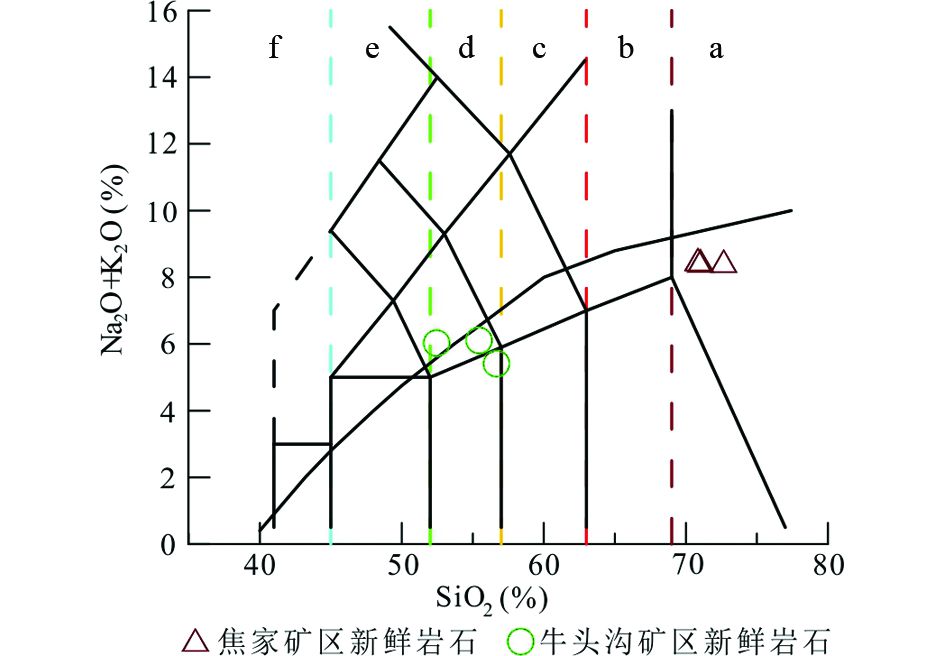
|
图 7 牛头沟金矿区及焦家金矿区新鲜岩石样品TAS图解 a-酸性岩区;b-中酸性岩区;c-中性岩区;d-中基性岩区;e-基性岩区;f-超基性岩区 a-felsic rock;b-intermediate-felsic rock;c-intermediate rock;d-intermediate-mafic rock;e-mafic rock;f-ultra-mafic rock Fig. 7 TAS diagram of fresh igneous rock samples from the Niutougou gold deposit and Jiaojia gold deposit |
收集到的上述2个地区28件岩石样品在Al2O3-Ti图解中的投点如图 8所示。
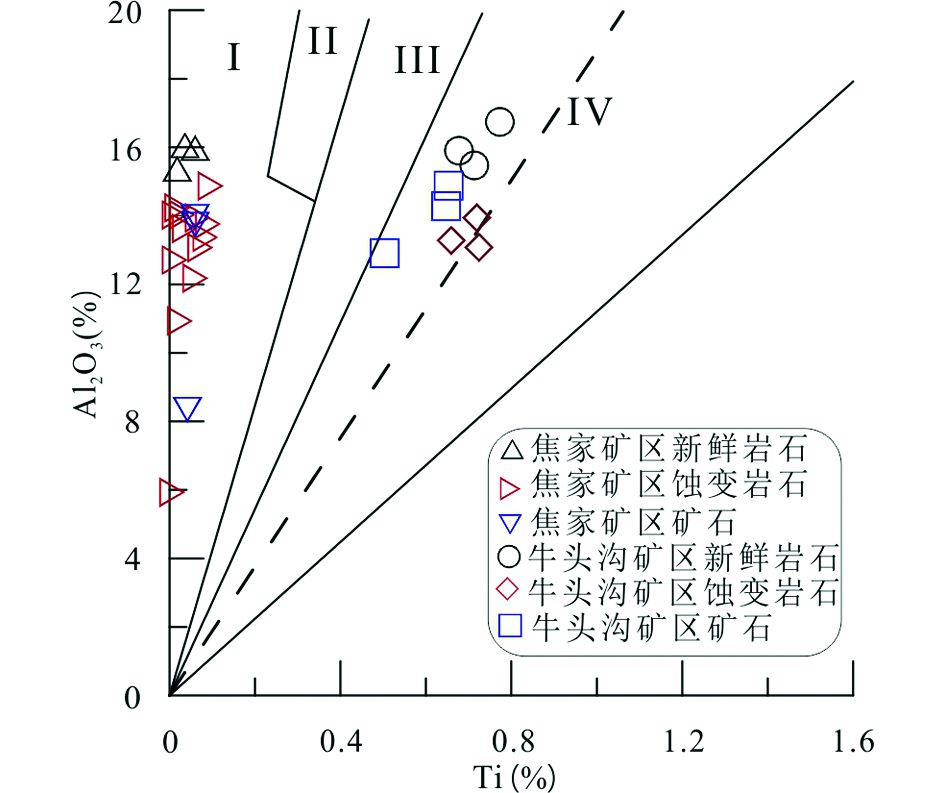
|
图 8 焦家矿区及牛头沟矿区岩石样品在Al2O3-Ti图解中的投点 Ⅰ-酸性岩;Ⅱ-中酸性岩;Ⅲ-中性岩;IV-中基性岩和基性岩 Ⅰ-felsic rock;Ⅱ-intermediate-felsic rock;Ⅲ-intermediate rock;IV-intermediate-mafic rock and mafic rock Fig. 8 Al2O3-Ti diagram of igneous rock samples from the Niutougou gold deposit and Jiaojia gold deposit |
从图 8可以看出,两个地区的岩石样品在Al2O3-Ti图解中分别聚集于两个不同区域内,焦家金矿区19件岩石样品均落在I区(即酸性岩区);牛头沟矿区9件岩石样品均落在IV区(中基性岩和基性岩区)。显然,对于胶东焦家金矿区岩石样品,黑云母花岗岩从新鲜岩石到蚀变岩再到矿石虽然经历不同程度的蚀变作用,其蚀变岩以及矿石中Al2O3/Ti的值保持在较小的变化范围,与其新鲜母岩在Al2O3-Ti图解中位置一致;对于牛头沟矿区玄武质安山岩,其新鲜岩石、蚀变岩石以及矿石的Al2O3/Ti的值也几乎保持不变。值得一提的是,牛头沟9件样品几乎都落在了IV中参照虚线的左侧,即偏中性岩,这与其母岩在TAS图解(图 7)中对应的岩性吻合。因此,Al2O3-Ti图解可以用来判别蚀变岩石的原岩。
6 结论(1) 火成岩中不活动元素比值Al2O3/Ti与SiO2含量存在较好的幂函数关系,经验方程为ln(Al2O3/Ti)= 0.073 × SiO2 - 0.89,式中Al2O3、SiO2和Ti元素含量单位均为%。
(2) 基于火成岩中Al2O3/Ti比值与SiO2含量的经验方程和TAS图解可以构建一个新的判别岩性的图解:Al2O3-Ti图解。构建的Al2O3-Ti图解可以较好地区分火成岩类型。当火成岩受风化或蚀变作用影响无法运用常用的TAS图解和QAPF图判别岩性时可以参照Al2O3-Ti图解,该图解可以大致判别风化或蚀变火成岩的母岩岩性,而且在运用Al2O3-Ti图解判别岩性时,无需剔除样品中H2O和CO2含量对氧化物含量进行重新换算,判别方法较为简单。
(3) Al2O3-Ti图解可以用来追溯火成岩风化产物的母岩,还可以用来判别火成岩蚀变产物的原岩。
致谢 感谢中国地质大学(北京)杨立强教授、王中亮讲师、刘宁强讲师在本文完成过程中提出的宝贵建议。| [1] | Barton MD, Ilchik RP, Marikos MA. 1991. Metasomatism. In:Kerick DM (ed.). Contact Metamorphism. Reviews in Mineralogy and Geochemistry , 26 (1) :321–349. |
| [2] | Braun JJ, Descloitres M, Riotte J, Fleury S, Barbiéro L, Boeglin JL, Violette A, Lacarce E, Ruiz L, Sekhar M, Kumar MSM, Subramanian S, Dupré B. 2009. Regolith mass balance inferred from combined mineralogical, geochemical and geophysical studies:Mule Hole gneissic watershed, South India. Geochimica et Cosmochimica Acta , 73 (4) :935–961. DOI:10.1016/j.gca.2008.11.013 |
| [3] | Cai JH, Yan GH, Mou BL, Ren KX, Song B, Li FT. 2005. Zircon U-Pb age, Sr-Nd-Pb isotopic compositions and trace element of Fangshan complex in Beijing and their petrogenesis significance. Acta Petrologica Sinica , 21 (3) :776–788. |
| [4] | Chen YJ, Pirajno F, Li N, Guo DS, Lai Y. 2009. Isotope systematics and fluid inclusion studies of the Qiyugou breccia pipe-hosted gold deposit, Qinling orogen, Henan Province, china:Implications for ore genesis. Ore Geology Reviews , 35 (2) :245–261. DOI:10.1016/j.oregeorev.2008.11.003 |
| [5] | Chi QH, Yan MC. 2007. Handbook of Elemental Abundance for Applied Geochemistry. Beijing:Geological Publishing House :1–148. |
| [6] | Condie KC, Sinha AK. 1996. Rare earth and other trace element mobility during mylonitization:A comparison of the Brevard and Hope Valley shear zones in the Appalachian Mountains, USA. Journal of Metamorphic Geology , 14 (2) :213–226. DOI:10.1046/j.1525-1314.1996.05899.x |
| [7] | Das A, Krishnaswami S. 2007. Elemental geochemistry of river sediments from the Deccan Traps, India:Implications to sources of elements and their mobility during basalt-water interaction. Chemical Geology , 242 (1-2) :232–254. DOI:10.1016/j.chemgeo.2007.03.023 |
| [8] | Deng J, Yang LQ, Sun ZS, Wang JP, Wang QF, Xin HB, Li XJ. 2003. A metallogenic model of gold deposits of the Jiaodong granite-greenstone belt. Acta Geologica Sinica , 77 (4) :537–546. |
| [9] | Deng J, Yang LQ, Ge LS, Wang QF, Zhang J, Gao BF, Zhou YH, Jiang SQ. 2006. Research advances in the Mesozoic tectonic regimes during the formation of Jiaodong ore cluster area. Progress in Natural Science , 16 (8) :777–784. DOI:10.1080/10020070612330069 |
| [10] | Deng J, Wang QF, Yang LQ, Zhou L, Gong QJ, Yuan WM, Xu H, Guo CY, Liu XW, Zhu XL. 2008. The structure of ore-controlling strain and stress fields in the Shangzhuang gold deposit in Shandong Province, China. Acta Geologica Sinica , 82 (4) :769–780. |
| [11] | Deng J, Wang QF, Wan L, Liu H, Yang LQ, Zhang J. 2011. A multifractal analysis of mineralization characteristics of the Dayingezhuang disseminated-veinlet gold deposit in the Jiaodong gold province of China. Ore Geology Reviews , 40 (1) :54–64. DOI:10.1016/j.oregeorev.2011.05.001 |
| [12] | Deng J, Gong QJ, Wang CM, Carranza EJM, Santosh M. 2014. Sequence of Late Jurassic-Early Cretaceous magmatic-hydrothermal events in the Xiong'ershan region, central China:An overview with new zircon U-Pb geochronology data on quartz porphyries. Journal of Asian Earth Sciences , 79 :161–172. DOI:10.1016/j.jseaes.2013.09.018 |
| [13] | Deng J, Wang QF. 2016. Gold mineralization in China:Metallogenic provinces, deposit types and tectonic framework. Gondwana Research , 36 :219–274. DOI:10.1016/j.gr.2015.10.003 |
| [14] | Duzgoren-Aydin NS, Aydin A, Malpas J. 2002. Re-assessment of chemical weathering indices:Case study on pyroclastic rocks of Hong Kong. Engineering Geology , 63 (1-2) :99–119. DOI:10.1016/S0013-7952(01)00073-4 |
| [15] | Gong QJ, Deng J, Yang LQ, Zhang J, Wang QF, Zhang GX. 2011. Behavior of major and trace elements during weathering of sericite-quartz schist. Journal of Asian Earth Sciences , 42 (1-2) :1–13. DOI:10.1016/j.jseaes.2011.03.003 |
| [16] | Gong QJ, Deng J, Wang CM, Wang ZL, Zhou LZ. 2013. Element behaviors due to rock weathering and its implication to geochemical anomaly recognition:A case study on Linglong biotite granite in Jiaodong Peninsula, China. Journal of Geochemical Exploration , 128 :14–24. DOI:10.1016/j.gexplo.2013.01.004 |
| [17] | Gong QJ, Deng J, Jia YJ, Tong YK, Liu NQ. 2015. Empirical equations to describe trace element behaviors due to rock weathering in China. Journal of Geochemical Exploration , 152 :110–117. DOI:10.1016/j.gexplo.2015.02.004 |
| [18] | Gong QJ, Yu JS, Han DY, Liu NQ, Tong YK, Jia YJ, Ma YT.2015. Geochemical Exploration Model for Niutougou Au Deposit and Quantitative Predication on Au Resources in Xiong'ershan Region, Western Henan Province, China. Beijing: Metallurgy Industry Press : 1 -174. |
| [19] | Gong QJ, Yan TT, Li JZ, Zhang M, Liu NQ. 2016. Experimental simulation of element mass transfer and primary halo zone on water-rock interaction. Applied Geochemistry , 69 :1–11. DOI:10.1016/j.apgeochem.2016.04.001 |
| [20] | Irvine TN, Baragar WRA. 1971. A guide to the chemical classification of the common volcanic rocks. Canadian Journal of Earth Sciences , 8 (5) :523–548. DOI:10.1139/e71-055 |
| [21] | Ji HB, Ouyang ZY, Wang SJ, Zhou DQ. 2000. Element geochemistry of weathering profile of dolomitite and its implications for the average chemical composition of the upper-continental crust. Science in China (Series D) , 43 (1) :23–35. DOI:10.1007/BF02877828 |
| [22] | Ji HB, Wang SJ, Ouyang ZY, Zhang S, Sun CX, Liu XM, Zhou DQ. 2004. Geochemistry of red residua underlying dolomites in karst terrains of Yunnan-Guizhou Plateau:I. The formation of the Pingba profile. Chemical Geology , 203 (1-2) :1–27. |
| [23] | Jia YJ, Gong QJ, Han DY, Liu NQ, Xia XL, Li XL. 2013. Sample granularity of soils and stream sediments in geochemical surveys:A case study of the Niutougou gold deposit, Xiong'ershan gold mine in Henan Province. Geology and Exploration , 49 (5) :928–938. |
| [24] | Le Maitre RW. 1989. A Classification of Igneous Rocks and Glossary of Terms. Oxford:Blackwell Scientific Publications :1–193. |
| [25] | Ma JL, Wei GJ, Xu YG, Long WG, Sun WD. 2007. Mobilization and re-distribution of major and trace elements during extreme weathering of basalt in Hainan Island, South China. Geochimica et Cosmochimica Acta , 71 (13) :3223–3237. DOI:10.1016/j.gca.2007.03.035 |
| [26] | Ma YT, Gong QJ, Han DY, Liu NQ, Yuan YT, Tong YK, Jia YJ. 2015. Behavior of major and trace elements during weathering of andesite:A case study of the Xiong' ershan Region, western Henan Province. Geology and Exloration , 51 (3) :545–554. |
| [27] | Mao JW, Goldfarb RJ, Zhang ZW, Xu WY, Qiu YM, Deng J. 2002. Gold deposits in the Xiaoqinling-Xiong'ershan region, Qinling Mountains, central China. Mineralium Deposita , 37 (3-4) :306–325. DOI:10.1007/s00126-001-0248-1 |
| [28] | Nesbitt HW, Markovics G. 1997. Weathering of granodioritic crust, long-term storage of elements in weathering profiles, and petrogenesis of siliciclastic sediments. Geochimica et Cosmochimica Acta , 61 (8) :1653–1670. DOI:10.1016/S0016-7037(97)00031-8 |
| [29] | Panahi A, Young GM, Rainbird RH. 2000. Behavior of major and trace elements (including REE) during Paleoproterozoic pedogenesis and diagenetic alteration of an Archean granite near Ville Marie, Québec, Canada. Geochimica et Cosmochimica Acta , 64 (13) :2199–2220. DOI:10.1016/S0016-7037(99)00420-2 |
| [30] | Pokrovsky OS, Schott J, Dupré B. 2006. Trace element fractionation and transport in boreal rivers and soil porewaters of permafrost-dominated basaltic terrain in Central Siberia. Geochimica et Cosmochimica Acta , 70 (13) :3239–3260. DOI:10.1016/j.gca.2006.04.008 |
| [31] | Rollison HR. 2000. Using Geochemical Data:Evaluation, Presentation, Interpretation. In:Yang XM, Yang XY and Chen SX (trans.). Hefei:Press of University of Science and Technology of China, 1-275 (in Chinese) |
| [32] | Streckeisen A. 1974. Classification and nomenclature of plutonic rocks recommendations of the IUGS subcommission on the systematics of Igneous Rocks. Geologische Rundschau , 63 (2) :773–786. DOI:10.1007/BF01820841 |
| [33] | Tong YK, Gong QJ, Han DY, Liu NQ, Xu ZY, Yu WL. 2014. Indicator element association in geochemical surveys:A case study of the Niutougou gold deposit in western Henan Province. Geology and Exploration , 50 (4) :712–724. |
| [34] | Wang XL, Jiang SY, Dai BZ. 2010. Melting of enriched archean subcontinental lithospheric mantle:Evidence from the ca. 1760Ma volcanic rocks of the Xiong'er Group, southern margin of the North China craton. Precambrian Research , 182 (3) :204–216. |
| [35] | Wang ZL. 2012. Metallogenic system of Jiaojia gold orefield, Shandong Province, China. Ph. D. Dissertation. Beijing:China University of Geosciences, 1-230 (in Chinese) |
| [36] | Wang ZL, Gong QJ, Sun X, Wu FF, Wang WX. 2012. LA-ICP-MS zircon U-Pb geochronology of quartz porphyry from the Niutougou gold deposit in Songxian County, Henan Province. Acta Geologica Sinica , 86 (2) :370–382. DOI:10.1111/j.1755-6724.2012.00666.x |
| [37] | Wu FF, Gong QJ, Shi JX, Li JQ, Wang ZL. 2012. Ore-controlling geological factors of gold deposits in the Xiong'ershan region, western Henan Province. Geology and Exploration , 48 (5) :865–875. |
| [38] | Xu HJ, Song YR, Ye K, Zhang JF, Wang HR. 2012. Petrogenesis of mafic dykes and high-Mg adakitic enclaves in the Late Mesozoic Fangshan low-Mg adakitic pluton, North China Craton. Journal of Asian Earth Sciences , 54-55 :143–161. DOI:10.1016/j.jseaes.2012.04.008 |
| [39] | Yang KF, Fan HR, Santosh M, Hu FF, Wilde SA, Lan TG, Lu LN, Liu YS. 2012. Reactivation of the Archean lower crust:Implications for zircon geochronology, elemental and Sr-Nd-Hf isotopic geochemistry of Late Mesozoic granitoids from northwestern Jiaodong Terrane, the North China Craton. Lithos , 146-147 :112–127. DOI:10.1016/j.lithos.2012.04.035 |
| [40] | Yang LQ, Zhang ZJ, Wang GJ, Deng J, Zhao AH, Wang JP. 2000. Lithospheric structure and deep-seated mineralization in Jiaodong gold deposit concentration region, Shandong, China. Earth Science , 25 (4) :421–427. |
| [41] | Yang LQ, Deng J, Wang QF, Gao BF, Xu H. 2006. Deep-seated tectonic and geological process controls on mineralization and mineral resources. Mineral Deposits , 25 (S1) :107–110. |
| [42] | Yang LQ, Deng J, Ge LS, Wang QF, Zhang J, Gao BF, Jiang SQ, Xu H. 2007. Metallogenic epoch and genesis of the gold deposits in Jiaodong Peninsula, eastern China:A regional review. Progress in Nature Science , 17 (2) :138–143. DOI:10.1080/10020070612331343237 |
| [43] | Yang LQ, Deng J, Zhang J, Wang QF, Gao BF, Zhou YH, Guo CY, Jiang SQ. 2007. Preliminary studies of fluid inclusions in Damoqujia gold deposit along Zhaoping fault zone, Shandong Province, China. Acta Petrologica Sinica , 23 (1) :153–160. |
| [44] | Yang LQ, Deng J, Guo CY, Zhang J, Jiang SQ, Gao BF, Gong QJ, Wang QF. 2009. Ore-forming fluid characteristics of the Dayingezhuang gold deposit, Jiaodong gold province, China. Resource Geology , 59 (2) :181–193. DOI:10.1111/rge.2009.59.issue-2 |
| [45] | Yang LQ, Deng J, Goldfarb RJ, Zhang J, Gao BF, Wang ZL. 2014. 40Ar/39Ar geochronological constraints on the formation of the Dayingezhuang gold deposit:New implications for timing and duration of hydrothermal activity in the Jiaodong gold province, china. Gondwana Research , 25 (4) :1469–1483. DOI:10.1016/j.gr.2013.07.001 |
| [46] | Yang LQ, Deng J, Wang ZL, Zhang L, Guo LN, Song MC, Zheng XL. 2014. Mesozoic gold metallogenic system of the Jiaodong Gold Province, eastern China. Acta Petrologica Sinica , 30 (9) :2447–2467. |
| [47] | Zhang BL, Yang LQ, Huan SY, Liu Y, Liu WL, Zhao RX, Xu YB, Liu SG. 2014. Hydrothermal alteration in the Jiaojia gold deposit, Jiaodong, China. Acta Petrologica Sinica , 30 (9) :2533–2545. |
| [48] | 蔡剑辉, 阎国翰, 牟保磊, 任康绪, 宋彪, 李凤棠.2005. 北京房山岩体锆石U-Pb年龄和Sr、Nd、Pb同位素与微量元素特征及成因探讨. 岩石学报 , 21 (3) :776–788. |
| [49] | 迟清华, 鄢明才. 2007. 应用地球化学元素丰度数据手册. 北京: 地质出版社 : 1 -148. |
| [50] | 龚庆杰, 喻劲松, 韩东昱, 刘宁强, 吴发富, 佟依坤, 贾玉杰, 马云涛. 2015. 豫西牛头沟金矿地球化学找矿模型与定量预测. 北京: 冶金工业出版社 : 1 -174. |
| [51] | 贾玉杰, 龚庆杰, 韩东昱, 刘宁强, 夏旭丽, 李晓蕾.2013. 化探方法技术之取样粒度研究——以豫西牛头沟金矿1: 5万化探普查为例. 地质与勘探 , 49 (5) :928–938. |
| [52] | 马云涛, 龚庆杰, 韩东昱, 刘宁强, 袁玉涛, 佟依坤, 贾玉杰.2015. 安山岩风化过程中元素行为——以豫西熊耳山地区为例. 地质与勘探 , 51 (3) :545–554. |
| [53] | Rollison HR.2000. 岩石地球化学. 合肥: 中国科学技术大学出版社 . |
| [54] | 佟依坤, 龚庆杰, 韩东昱, 刘宁强, 徐增裕, 于文龙.2014. 化探技术之成矿指示元素组合研究——以豫西牛头沟金矿为例. 地质与勘探 , 50 (4) :712–724. |
| [55] | 王中亮. 2012. 焦家金矿田成矿系统. 博士学位论文. 北京:中国地质大学, 1-230 http://cdmd.cnki.com.cn/article/cdmd-11415-1012364390.htm |
| [56] | 吴发富, 龚庆杰, 石建喜, 李建全, 王中亮.2012. 熊耳山矿集区金矿控矿地质要素分析. 地质与勘探 , 48 (5) :865–875. |
| [57] | 杨立强, 王光杰, 张中杰, 邓军, 赵爱华, 王建平.2000. 胶东金矿集中区岩石圈结构与深部成矿作用. 地球科学 , 25 (4) :421–427. |
| [58] | 杨立强, 邓军, 王庆飞, 高帮飞, 徐浩.2006. 深部构造与地质过程控矿研究. 矿床地质 , 25 (S1) :107–110. |
| [59] | 杨立强, 邓军, 张静, 王庆飞, 高帮飞, 周应华, 郭春影, 江少卿.2007. 山东招平断裂带大磨曲家金矿床流体包裹体初步研究. 岩石学报 , 23 (1) :153–160. |
| [60] | 杨立强, 邓军, 王中亮, 张良, 郭林楠, 宋明春, 郑小礼.2014. 胶东中生代金成矿系统. 岩石学报 , 30 (9) :2447–2467. |
| [61] | 张炳林, 杨立强, 黄锁英, 刘跃, 刘文龙, 赵荣新, 徐咏彬, 刘胜光.2014. 胶东焦家金矿床热液蚀变作用. 岩石学报 , 30 (9) :2533–2545. |
 2016, Vol. 32
2016, Vol. 32


